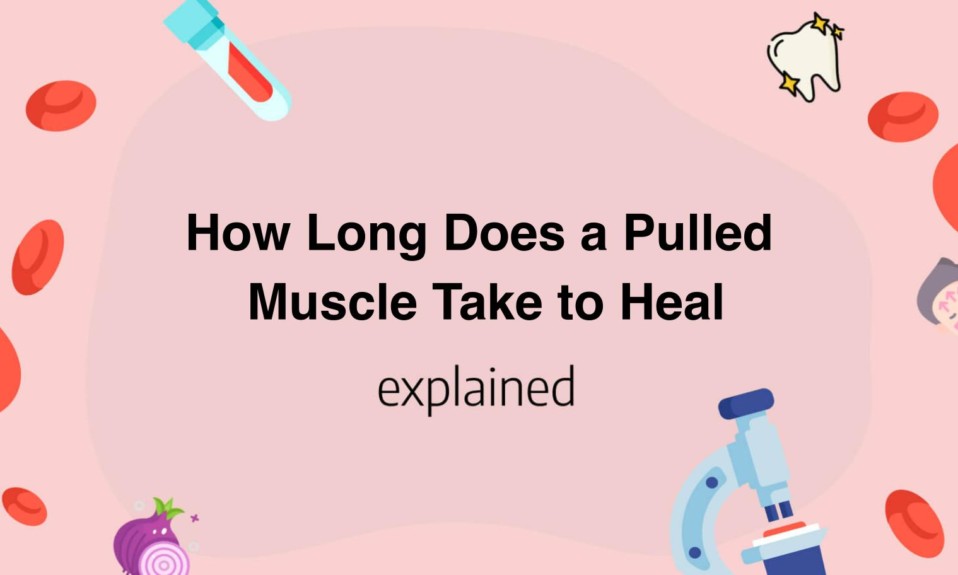If you’ve ever experienced a pulled muscle, you know how uncomfortable and painful it can be.
But one of the most frustrating aspects of this injury is the time it takes to heal.
So, how long does a pulled muscle take to heal? The length of recovery time varies depending on the severity of the injury and the location of the affected muscle.
To get a better idea of what to expect, let’s explore this topic in more detail.
How Long Does a Pulled Muscle Take to Heal ?
The healing time for a pulled muscle depends on the severity of the injury.
In general, mild to moderate muscle strains may take a few days to a few weeks to heal, while more severe strains can take several weeks or even months to fully recover.
During the initial stages of a pulled muscle injury, the focus is on reducing pain and inflammation.
Rest, ice, compression, and elevation (RICE) are commonly used to treat this type of injury. Over-the-counter pain medications can also be helpful.
After the initial acute phase, physical therapy and rehabilitation exercises are recommended to help restore range of motion and muscle strength. It is important to gradually return to physical activity to avoid re-injury.
It is important to note that every person’s body is different, and healing time can vary depending on age, overall health, and the specific muscle involved.
If you are experiencing severe pain or if your symptoms are not improving, it is important to seek medical attention.
Causes of Pulled Muscles and Their Impact
Pulled muscles can happen to anyone, regardless of age or fitness level.
They are a common injury that occurs when a muscle is stretched or torn beyond its normal range of motion.
One of the main causes of pulled muscles is improper warm-up or lack thereof.
Stretching and warming up before exercise can help prevent pulled muscles.
Another cause of pulled muscles is overuse or repetitive strain, such as in sports or manual labor jobs.
If the same muscle is repeatedly used without proper rest, it can result in a pulled muscle.
Additionally, muscle imbalances can also lead to pulled muscles.
If one muscle group is stronger than the other, the weaker group has to work harder to compensate, which can result in an injury.
The impact of a pulled muscle can range from mild discomfort to severe pain, swelling and bruising.
Depending on the severity of the injury, a pulled muscle can take anywhere from a few days to several weeks to heal.
In some cases, rehabilitation exercises may be necessary to restore muscle strength and flexibility.
Pulled muscles can also impact daily activities and limit mobility.
For example, a pulled hamstring can make it difficult to walk or climb stairs.
If left untreated or not allowed the proper time to heal, a pulled muscle can lead to chronic pain and further injury.
Preventing pulled muscles involves proper warm-up, stretching, and balance training.
It is also important to gradually increase exercise intensity and rest when necessary.
- If you are an athlete, ensure your training is well-rounded and includes rest days.
- If you work a physical job, take frequent breaks and stretch throughout the day.
- Proper nutrition and hydration can also help prevent pulled muscles.
In conclusion, pulled muscles are a common injury that can impact daily life.
However, with proper preventative measures and care, the risk of pulled muscles can be reduced.
Symptoms of a Pulled Muscle and How to Recognize Them
If you’ve ever experienced a pulled muscle, you know the pain can be excruciating.
A pulled or strained muscle occurs when the fibers or tendons in the muscle stretch too far or tear.
The most common symptoms of a pulled muscle include pain, swelling, and difficulty moving the affected muscle.
Depending on the severity of the strain, you may also feel a popping or snapping sensation when the injury occurs.
It’s important to recognize the symptoms of a pulled muscle early on so that you can take steps to facilitate healing and prevent further damage.
One of the most effective ways to treat a pulled muscle is through RICE:
- Rest the affected area and avoid activities that exacerbate the pain;
- Ice the affected area to reduce inflammation and pain;
- Compress the muscle with a bandage or wrap to reduce swelling;
- Elevate the affected area to reduce swelling and promote healing.
In some cases, you may need more intensive treatment, such as physical therapy or medications.
While it’s important to treat a pulled muscle promptly and effectively, it’s also important to take steps to prevent them from occurring in the first place.
Proper stretching and warm-up techniques can help reduce your risk of muscle strains, as can using proper form and technique when exercising or engaging in physical activity.
If you do experience a pulled muscle, be sure to give yourself plenty of time to rest and recover before returning to your normal activities.
By taking these steps, you can help ensure the health and longevity of your muscles, and avoid the pain and discomfort of a pulled muscle.
Common Treatments for Pulled Muscles and Their Effectiveness
Pulled muscles, also known as muscle strains, are a common injury that can occur when a muscle is stretched beyond its limits or is used incorrectly.
Some of the most common areas where muscle strains occur include the back, neck, shoulder, and hamstring.
When a muscle strain occurs, it’s important to take action right away to prevent further damage and speed up recovery time.
One of the most effective treatments for pulled muscles is the RICE method, which stands for rest, ice, compression, and elevation.
Resting the affected muscle will allow it to heal properly without further strain, while applying ice to the area will help reduce swelling and inflammation.
Compression, such as wrapping the injured area with an elastic bandage, can also help reduce swelling and provide support.
Elevation by keeping the injured area above heart level will help decrease swelling by allowing fluid to drain away from the area.
Another treatment option for pulled muscles is physical therapy.
This option is particularly effective for patients with persistent muscle strains or who have developed scar tissue in the affected area.
Physical therapy can help improve flexibility and strength in the affected muscle, as well as help the patient learn exercises and stretching techniques to prevent further injury.
The use of massage therapy can also be effective in treating pulled muscles.
Therapeutic massage can help increase blood flow to the affected area, which can help promote healing and reduce inflammation.
In addition, massage therapy can help relieve tension and stress in the affected muscle, which can help reduce the risk of further injury.
Finally, for severe muscle strains, surgery may be necessary.
Surgery is typically reserved for cases where the muscle is completely torn or there is significant damage to the surrounding tendons or ligaments.
In these cases, surgery can help repair the injured area and improve mobility and function.
In conclusion, while the severity of muscle strains can vary, it’s important to take action right away to prevent further injury and speed up recovery time.
The RICE method, physical therapy, massage therapy, and surgery are all effective treatment options for pulled muscles, each with their unique benefits and purposes.
By knowing your options and working with your medical professional, you can effectively treat your muscle strain and return to your daily activities in no time.
Read also: How to Stop Tooth Pain Fast
How to Prevent Pulled Muscles during Physical Activity
Pulled muscles are one of the most common injuries people experience during physical activity.
To prevent a pulled muscle, the first step is to properly warm up before exercising.
Stretching is an effective way to increase blood flow to the muscles and to loosen them up for the activity ahead.
Be sure to stretch after exercising as well to help prevent soreness and tightness.
Another way to prevent pulled muscles is to build strength gradually.
Starting with light weights and slowly increasing the weight or intensity over time helps give the muscles a chance to adjust and strengthen accordingly.
- If you are new to exercise or returning after a long break, consider working with a trainer to develop an appropriate routine.
- Take sufficient rest between workouts, giving the muscles time to recover and rebuild.
- It is also important to stay hydrated before, during, and after exercising to prevent muscle cramps and to maintain overall health.
Additionally, it is important to be mindful of proper form and technique during exercise.
Poor technique can place undue stress on muscles, leading to an increased risk of injury.
Finally, consider incorporating low-impact activities into your routine, such as yoga or swimming, to provide a break from high-impact activities like running or weightlifting.
By taking these steps, you can greatly reduce the risk of experiencing a pulled muscle during physical activity.
Remember to always listen to your body and stop exercising if you experience any pain or discomfort.
Read also: How to Pull Out a Tooth Easily
Factors That Affect the Healing Time of Pulled Muscles
There are several factors that can affect the healing time of pulled muscles.
One of the most significant factors is the severity of the injury.
A mild strain can heal in a few days, while a severe strain may take several weeks or even months to heal completely.
Depending on the severity of the strain, it may be necessary to rest the affected muscle and refrain from any physical activity, such as exercise or sports, until it has had time to fully heal.
Another factor that can affect the healing time of pulled muscles is the age of the individual.
As we age, our bodies become less efficient at repairing damaged tissues.
Older adults may therefore experience longer healing times compared to younger individuals.
They may also need to take extra steps to protect the injured muscle, such as wearing supportive braces or seeking physical therapy.
The location of the strain can also impact healing time.
Muscles that are under a lot of tension, such as the hamstrings or calf muscles, may take longer to heal than those that are not under as much stress.
Additionally, muscles that are closer to the body’s core may heal more quickly than those that are further away.
Finally, a person’s overall health and lifestyle can impact healing time.
Eating a healthy diet, getting enough rest, and not smoking can all contribute to a faster healing process.
On the other hand, poor nutrition, lack of sleep, and smoking can all slow down the healing process.
In conclusion, there are several factors that can affect the healing time of pulled muscles.
The severity of the injury, age of the individual, location of the strain, and overall health and lifestyle all play a role.
By taking steps to promote healing, such as getting adequate rest, eating a healthy diet, and seeking medical attention when necessary, individuals can help to speed up the healing process and get back to their normal activities as quickly as possible.
You’ll also like:










